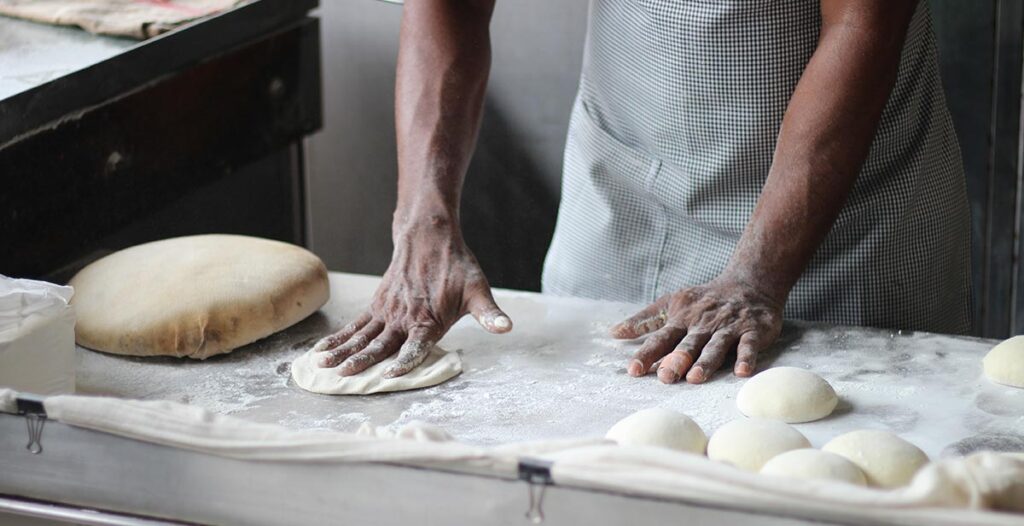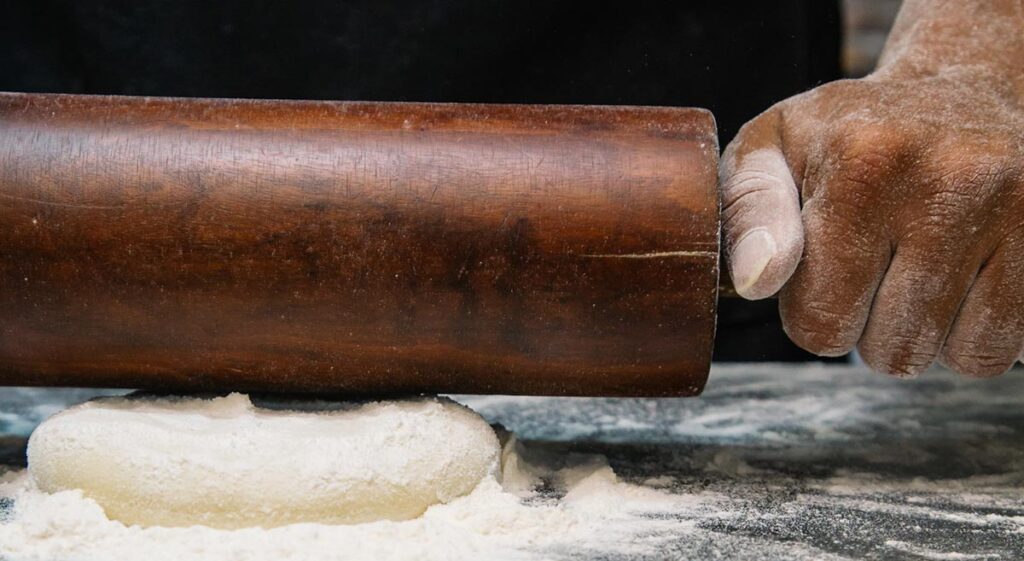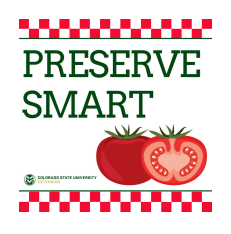A Guide to High-Elevation Food Preparation

Newcomers to Colorado or those traveling to the mountains are often surprised when their favorite recipes at sea level fail to produce expected results when made at higher elevations. At heights 3,000 feet above sea level and higher, preparation of food may require changes in time, temperature and/or ingredients due to lower atmospheric pressure. Air pressure decreases as elevation increases.
In other words, the blanket of air above us is lighter. At sea level, atmospheric pressure is 14.7 pounds per square inch (psi), at 5,000 feet it’s 12.3 psi, and at 10,000 feet only 10.2 psi – a decrease of about 1/2 pound per 1,000 feet.
Decreased pressure affects food preparation in two major ways:
- Water and other liquids evaporate faster and boil at lower temperatures.
- Leavening gases in breads and cakes expand more quickly.
Whether boiling eggs, baking bread, or making cookies, small adjustments can often improve the results. The Department of Food Science and Human Nutrition at Colorado State University has a long history of addressing challenges associated with preparing and preserving food at higher elevations.
| Table 1: Approximate boiling temperatures of water at various elevations | |
| Elevation | Temperature |
| Sea Level | 212 degrees F |
| 2,000 ft. | 208 degrees F |
| 5,000 ft. | 203 degrees F |
| 7,500 ft. | 198 degrees F |
| 10,000 ft. | 194 degrees F |
Need some help? Ask an Extension Agent.

High-Elevation Cooking
The temperature at which water boils declines as elevation rises (Table 1). Because of this, foods prepared by boiling or simmering cook at a lower temperature at high elevation than at sea level, and thus, require a longer cooking time. This includes vegetables, beans, pot roasts, soups and stews.
- Meats cooked by simmering or braising may require one-fourth more time at 5,000 feet than at sea level.
- Hard-cooked eggs will take longer to cook. A “3-minute” egg may take 5 minutes to cook at 5,000 feet.
- Oven temperatures, however, are not affected by elevation, so sea-level instructions work for oven-roasted meats.
- High elevation areas are also prone to low humidity, which causes the moisture in foods to evaporate more quickly during cooking. Covering foods during cooking will help hold in moisture.
Deep-fat Frying at High Elevations
The lower boiling point of water in foods requires lowering the temperature of the fat to prevent food from over browning on the outside while being under-cooked on the inside. The decrease varies according to the food being fried, but as an estimate:
Preserve Smart is a website/mobile phone app featuring basic information about home food preservation with a built-in function that adapts recipes to the user’s elevation. Home canning, drying, and/or freezing methods are provided for over 55 types of fruits and vegetables. A glossary and basic information about preservation methods and equipment is also included.
High-Elevation Microwave Cooking
Due to faster evaporation of liquids at high elevation, microwave cooking times may need to be adjusted. Follow your recipe or package instructions and use a food thermometer to determine if the safe minimum internal temperature has been reached. Cook longer if necessary.

Slow Cookers at High Elevation
At high elevations, slow cookers simmer at a lower temperature, making it more difficult for food to reach a safe temperature and for bacteria to be destroyed. If your slow cooker has an adjustable temperature control, select a setting that will maintain the food at 200 °F or higher. If your slow cooker has both a high and low setting, start the food cooking on high for the first hour; hen either continue to use high or turn it to the low setting for the remainder of cooking. Allow longer cooking times at high elevation and do not remove the lid. It can take 20 minutes or longer for the lost steam and heat to be regained each time the lid is lifted. For more information see: Crockpot and Slow Cooker Food Safety.
High-Elevation Candy Making
Both humidity and elevation affect candy making. To prevent excessive water evaporation while cooking sugar mixtures at elevation, cook to a “finish” temperature that is lower than that given in sea-level recipes. If you use a candy thermometer, first test the temperature at which your water boils, then reduce the finish temperature by the difference between the temperature of your boiling water and 212 °F. This is an approximate decrease of 2°F for every increase of 1,000 feet in elevation. You may also use the cold-water test, which is reliable at any elevation. See Candy Making at High Elevation for information on this method and other high elevation candy making tips.
High-Elevation Puddings and Cream-Pie Fillings
Above 5,000 feet, temperatures obtained with a double boiler are not high enough for maximum gelatinization of starch. Therefore, use direct heat rather than a double boiler.
Freezing at High Elevations
An important step in preparing vegetables for freezing is heating or “blanching” before packing. At 5,000 feet elevation or higher, heat 1 minute longer than the blanching time given for sea level. For more information and tips on freezing food, see: Freezing Food: The Science.
High-Elevation Canning
Fruits and pickled vegetables can be safely canned in a boiling water bath, as well as tomatoes that have been properly acidified. However, because the temperature of boiling water is lower at higher elevations, follow these guidelines for boiling water bath canning at elevation:
- Increase processing time by 1 minute for each 1,000 feet above sea level if the sea level processing time is 20 minutes or less.
- If the sea level processing time is more than 20 minutes, increase by 2 minutes per 1,000 feet.
Other vegetables, meats and poultry (low-acid foods) must be canned in a pressure canner at 240 °F for the appropriate time to destroy heatresistant bacteria. At sea level to 2000 feet, 11 pounds of steam pressure will produce this temperature. Above 2,000 feet, steam pressure must be increased to reach 240 °F as illustrated in Table 2.
| Table 2: Pressure required to reach 240 degrees F. | |
| Elevation | Pressure Required |
| Sea Level-2,000 ft. | 11 lb. |
| 2,001-4,000 ft. | 12 lb. |
| 4,001-6,000 ft. | 13 lb. |
| 6,001-8,000 ft. | 14 lb. |
| 8,001-10,000 ft. | 15 lb. |
High-Elevation Baking

Yeast Breads
With yeast breads, decreased atmospheric pressure at higher elevations allows the dough to rise too fast, negatively impacting texture and flavor. To counteract this effect, less yeast may be used or the dough can be punched down and allowed to rise a second time before molding into loaves or rolls. Watch carefully to prevent over-rising. Allow dough to rise until just doubled in bulk, as over-proofing can result in a heavy, dry loaf or a misshapen or collapsed loaf.
Flours tend to be drier and absorb more liquid in high, dry climates. Therefore, less flour or additional liquid may be needed to moisten the dough to the proper consistency.
Yeast breads benefit from flour with a higher protein content compared to other more tender baked products. For improved texture and volume, especially when baking at higher elevations, use flour with at least 12% protein. Bread flour or whole-wheat flour usually have higher protein content than other types of flour.
For information specifically related to making sourdough bread, see Sourdough Basics: Caring for your Starter and Making Bread.
Bread Machines
Many bread machine manuals offer tips and settings for high elevation baking. General suggestions include:
- Decrease yeast by ¼ to ½ tsp. for every package (2 ½ tsp.) called for in the recipe.
- Add 1 to 2 T. of additional liquid per cup of flour. Be careful not to add too much liquid. The dough must come clean from the sides during the final stages of mixing.
- To allow gluten to develop more fully, use a longer mixing cycle.
Biscuits, Muffins, and Quick Breads
Quick breads vary from muffin-like to cake-like in cell structure. The structure of biscuits and muffin type quick breads is often firm enough to withstand the effects of reduced pressure at higher elevations. However, if recipe adjustments are not made, a bitter or alkaline flavor may result from inadequate neutralization of baking soda or baking powder. Slightly reducing these leaveners will usually improve results. Quick breads with a cake-like texture are more delicately balanced and can be improved at high elevations by following the adjustment recommendations given for cakes (Table 3)..
Cookies
Many cookie recipes contain a high volume of sugar and fat, which can cause cookies to sprawl on the baking sheet even at low elevations. Although many sea-level cookie recipes yield acceptable results at high elevation, they are often improved by one or more of these changes:
A slight decrease in:
- baking powder or soda
- fat and/or sugar
A slight increase in:
- liquid ingredients and flour
- baking temperature
Note: Chilling cookie dough or using parchment paper on cookie sheets may help decrease spread during baking.
Pie Crusts
Although not generally affected by elevation, slightly more liquid may improve texture. To prevent a soggy crust, it can help to bake the pie in the lower third of the oven, closer to the heating element.
Making Cakes at High Elevations

Most one-bowl cake recipes perfected for sea level need no modifications up to 3,000 feet. Above that, decreased atmospheric pressure may result in excessive rising, which stretches the cell structure of the cake, making the texture coarse, or breaks the cells, causing the cake to fall. Table 3 illustrates adjustments to make:
- Leavening: Measure accurately and reduce both baking powder and/or baking soda. Increase baking temperature by 15 to 25 °F to help “set” the batter before cells formed by the leavening gas expand too much. Note that baking time may be reduced so check during baking.
- Excessive evaporation of water at high elevation leads to high concentration of sugar, which weakens the cell structure. Therefore decrease sugar in the recipe and increase liquid.
- When making rich cakes at high elevations, you might have to reduce shortening by 1 or 2 tablespoons. Fat, like sugar, weakens the cell structure. Also, increasing the amount of egg strengthens the cell structure and may prevent the rich cake from falling.
Foam Cakes (Angel Food or Sponge)
The leavening gas for these is largely air. Beat egg whites only until they form shiny peaks that droop slightly – not stiff and dry, which will cause collapse of cells. Strengthen cell structure by using less sugar and more flour, and a higher baking temperature.
Cake Mixes
Suggestions for high-elevation adjustments are provided on most cake mix boxes. Adjustments usually include adding all-purpose flour and liquid because the leavener cannot be decreased.
Gluten-Free Baking
When wheat flour is replaced with gluten-free flour(s), high elevation challenges remain, although there are no set guidelines on how to successfully compensate for the elevation change. The home cook is advised to experiment with recipes, first making any necessary adjustments for the elevation change and then altering the recipe further as needed to adjust for the properties of gluten-free flours.
More information is available in the Gluten-Free Baking fact sheet.
| Table 3: Cake-recipe adjustment for high elevation. | |||
| Adjustment | 3,500 to 6,500 ft. | 6,500 to 8,500 ft. | 8,500 to 10,000 ft. |
| Reduce baking powder, for each tsp., decrease: | 1/8 tsp. | 1/8-1/4 tsp. | 1/4 tsp. |
| Reduce sugar, for each cup, decrease: | 0-1 Tbsp. | 0-2 Tbsp. | 1-3 Tbsp. |
| Increase liquid, for each cup, add: | 1-2 Tbsp. | 2-4 Tbsp. | 3-4 Tbsp. |
Practical Baking Notes
- Do not assume that your sea level recipe will fail. Try it first. It may need little or no modification.
- Often, repeated experiments with each recipe can give the most successful proportions to use. As a starting point, refer to Table 3. Try the smaller adjustment first, this may be all that is needed.
- Take notes to keep track of which adjustments resulted in improvements.
- For improved nutrition and a heartier texture, substitute whole wheat pastry flour for half the all-purpose flour called for in cookie, cake, and pie recipes.
- Food tends to taste blander at higher elevations; above 7000 feet extra spices or flavorings may be needed to enhance flavors of baked goods.
- Take non-stick precautions seriously! At higher elvations, baked goods have a higher tendency to stick to pans.
Ask Extension
For expert answers and help from Extension/University staff and volunteers from across the United States, go to: ask2.extension.org
Also visit the CSU Extension FoodSmart Colorado website for printable high-elevation food preparation and preservation fact sheets, including:
- Gluten-free Baking
- Making Jellies
- Canning Fruit and Vegetables
- Canning Tomatoes and Tomato Products
- Making Pickles
- …and more
CSU Extension County Offices
Family & Consumer Sciences Extension agents can assist you with:
- Food safety information and classes
- Food preservation workshops
- Master Food Safety Advisor volunteers
- Pressure canner gauge testing
- Cottage food business product support and more
References
Developed by Patricia Kendall, CSU Food Science & Human Nutrition professor and Extension specialist ; revised 2023 by Marisa Bunning, CSU Food Science & Human Nutrition professor and Extension specialist and Elisa Shackelton, Extension specialist






